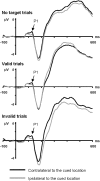Express attentional re-engagement but delayed entry into consciousness following invalid spatial cues in visual search
- PMID: 19088847
- PMCID: PMC2597733
- DOI: 10.1371/journal.pone.0003967
Express attentional re-engagement but delayed entry into consciousness following invalid spatial cues in visual search
Abstract
Background: In predictive spatial cueing studies, reaction times (RT) are shorter for targets appearing at cued locations (valid trials) than at other locations (invalid trials). An increase in the amplitude of early P1 and/or N1 event-related potential (ERP) components is also present for items appearing at cued locations, reflecting early attentional sensory gain control mechanisms. However, it is still unknown at which stage in the processing stream these early amplitude effects are translated into latency effects.
Methodology/principal findings: Here, we measured the latency of two ERP components, the N2pc and the sustained posterior contralateral negativity (SPCN), to evaluate whether visual selection (as indexed by the N2pc) and visual-short term memory processes (as indexed by the SPCN) are delayed in invalid trials compared to valid trials. The P1 was larger contralateral to the cued side, indicating that attention was deployed to the cued location prior to the target onset. Despite these early amplitude effects, the N2pc onset latency was unaffected by cue validity, indicating an express, quasi-instantaneous re-engagement of attention in invalid trials. In contrast, latency effects were observed for the SPCN, and these were correlated to the RT effect.
Conclusions/significance: Results show that latency differences that could explain the RT cueing effects must occur after visual selection processes giving rise to the N2pc, but at or before transfer in visual short-term memory, as reflected by the SPCN, at least in discrimination tasks in which the target is presented concurrently with at least one distractor. Given that the SPCN was previously associated to conscious report, these results further show that entry into consciousness is delayed following invalid cues.
Conflict of interest statement
Figures





References
-
- Posner MI. Orienting of attention. Q J Exp Psychol. 1980;32:3–25. - PubMed
-
- Hawkins HL, Shafto MG, Richardson K. Effects of target luminance and cue validity on the latency of visual detection. Percept Psychophys. 1988;44:484–492. - PubMed
-
- Müller HJ, Findlay JM. Sensitivity and criterion effects in the spatial cuing of visual attention. Percept Psychophys. 1987;42:383–399. - PubMed
-
- Shaw ML. Division of attention among spatial locations: A fundamental difference between detection of letters and detection of luminance increments. In: Bouma H, Bouwhuis DG, editors. Attention and performance X: Control of language processes. Hillsdale, NJ: Erlbaum; 1984. pp. 109–122.
-
- Mangun GR. Neural mechanisms of visual selective attention. Psychophysiology. 1995;32:4–18. - PubMed
Publication types
MeSH terms
LinkOut - more resources
Full Text Sources

